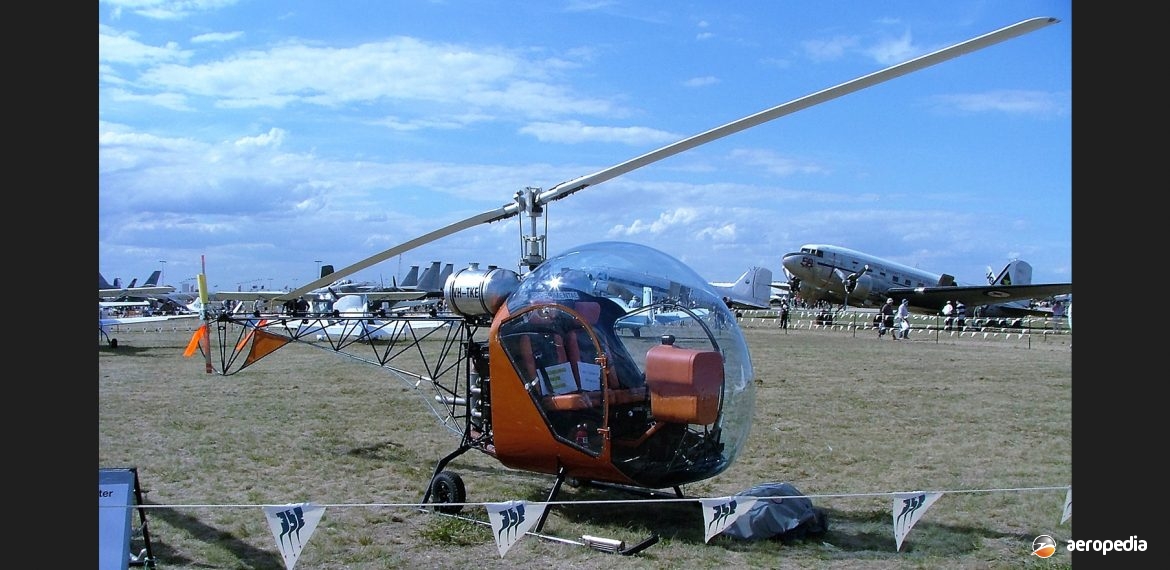Photograph:
Canadian Home Rotors Safari VH-TKE (c/n 0307N) at Avalon, VIC (David C Eyre)
Country of origin:
Canada
Description:
Two-seat light sport helicopter
Power Plant:
One 134 kw (180 hp) Lycoming O-360-C2C four-cylinder horizontally-opposed air-cooled engine
Specifications:
- Length: 9.22 m (30 ft 3 in)
- Height: 2.44 m (8 ft 0 in)
- Main rotor diameter: 7.72 m (25 ft 4 in)
- Never exceed speed: 161 km/h (100 mph)
- Max speed: 161 km/h (100 mph)
- Cruising speed: 137 km/h (85 mph)
- Service ceiling: 3,000 m (10,000 ft)
- Rate of climb: 305 m/min (1,000 ft/min)
- Range: 435 km (270 miles)
- Fuel capacity: 106 litres (23 Imp gals)
- Hovering ceiling in ground effect: 2,134 m (7,000 ft)
- Hovering ceiling out of ground effect: 1,524 m (5,000 ft)
- Empty weight: 431 kg (950 lb)
- Loaded weight: 726 kg (1,600 lb)
History:
This series of light sport helicopters was founded in the 1950s and was known as the Helicom, evolving into the Commuter, and later the Commuter II. Manufacturing rights were then sold to one of the original partners, which became Canadian Home Rotors Inc and the helicopter was sold for many years as a kit for construction by the amateur builder.
It was introduced to the public at the Experimental Aircraft Association (EAA) AirVenture event at Oshkosh, Wisconsin in 1992 and became known as the Baby Belle because of its similarity to the Bell 47 series, but the name was later changed to Safari.
The design has been constantly improved over the years, the aim being to produce a safe, simple and economical helicopter with a proven engine. The main rotor was of composite construction and the tail rotor was constructed from titanium. The main transmission, main rotor head, rotor blades and tail rotor were assembled at the Company’s facility at Marianna, Florida.
More than 130 examples have been built with the highest proportion of aircraft based in the United States. A new model known as the Safari 400 was introduced to the public at the EAA event in Wisconsin in 2011. The Company has also been developing a modified single-seat model with a load capacity of 295 kg (650 lb) for spraying operations, and has also looked at building an example as an Unmanned Aerial Vehicle (UAV).
By late 2016 12 examples were flying in New Zealand, with the type imported by South Pacific Home Rotors, which was founded in 2002, based at Te Awamutu. This company has been involved in improving the design to meet local conditions and these have involved the installation of titanium tail rotor blades, an electronic governor system, and a Kiwi-Pod luggage system. Another change was the canting of the main rotor transmission forward slightly, an all-titanium tailboom, new pedal linkages, a widening of the internal frame leading to more cabin room, angling the cabin floor to be flat at cruise speed, a transmission oil cooler and a new collective actuator system. These and other changes have meant the new model available in the south Pacific became known as the Safari 600. The Safari 600 was 27 kg (50 lb) lighter than the 400 and was able to climb at 366 m/min (1,200 ft/min).

